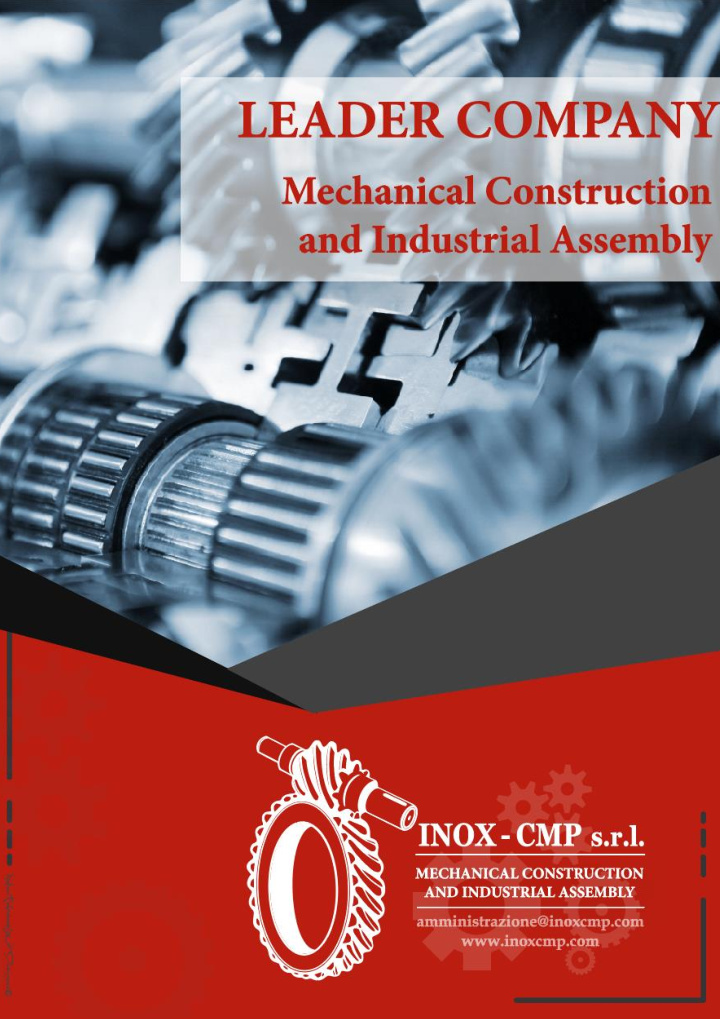



INOX-CMP S.r.1.-Cap. Soc. E. 46.800,00 IV.-C.C.I.AA. Latina 88069-Tribunale Latina Reg. Soc. n.14543 P.IVA e Cod. Fisc. 01414920593
COMPANY GENERAL DATA: Company INOX-CMP S.r.l. Nat i on ITALIA Address Via della Stazione km . 5,604 LATINA SCALO (LT) ZIP code 04100 P h o n e +39 0773 631171/2 Reference People Mr. Palleschi Franco Mr. Palleschi Bruno Mr. Palleschi Giuseppe E-mail amministrazione@inoxcmp.com inox.cmp@pec.it Web Site www.inoxcmp.com INOX-CMP S.r.1.-Cap. Soc. E. 46.800,00 IV.-C.C.I.AA. Latina 88069-Tribunale Latina Reg. Soc. n.14543 P.IVA e Cod. Fisc. 01414920593
COMPANY HISTORY The company was founded in 1988 between some ex FINDUS S.p.A. workers. After the first job experiences in an other building, in 1989 the Company built an industrial building of 1250mq plus another 400mq building for offices and services on a land of property. The increasing needs to supply to clients turnkey plants with all electrical equipment, pneumatic equipment for control and process management, push the Company to fund S.EL.PAM S.n.c. composed by the the same owners but now completely indipendent. INFORMATIONS ABOUT COMPANY ACTIVITIES 1. WORKING FIELDS ⚫ Dairy industry ⚫ Food industry ⚫ Chemical industry ⚫ Pharmaceutical industry ⚫ Mechanical industry 2. JOB CATEGORY Design, material supply chain, building, mounting fo metal carpentry, process lines, technological plant, machineries, power cabinet in LT and MT, electrical distribution plants, process automation by PLC and SCADA.
MAIN ACTIVITIES: Engineering 1. ⚫ Mechanical design ⚫ Electropneumatic design ⚫ Electrical and electromechanical design ⚫ PLC software developing ⚫ Analysis and developing of process software maintenance. ⚫ Production, control and release of engineering documentation. 2. Industrial mounting ⚫ Industrial metal carpentry ⚫ Compressed air production and distribution ⚫ Steam production and distribution ⚫ Hydro systems (potable water, fire system and technological services) ⚫ Purifiers ⚫ Metal carpentry, tanks, manifold and distribution lines in stainless steel ⚫ Production, transformation, packaging and trasferring plants for dairy and food industry. ⚫ CIP (Cleaning In Place) systems. ⚫ Glass transport and movement. ⚫ Pallett movement systems. ⚫ Packaging machines and manipulators
3. Automation system realization Electromechanical systems using the wired logic for control and control of packaging machines, conveyor lines, pump groups, utility start-ups in general, etc. Programmable logic electronic systems for the control and control of industrial machinery and plants. These systems are commonly equipped with PLC (Omron) usually connected to one or more MMI (Man Machine Interface) stations in the network with the PLC. Using an MMI type device, the operator can interact with the system by monitoring process variables and alarms, forcing process variables. etc. The transmission of the signals for the acquisition of process values from the field and for the control of the utilities can be performed using traditional cabling or Device-Net and / or ASI-Bus field buses on which through a simple twisted bipolar cable and screened connect peripheral devices of different types (digital, analog, MMI, inverter, serial ports, PLC, vision systems, process instrumentation, etc ) Complex electronic systems with programmable logic for the control and control of industrial processes. Such distributed control systems are usually provided with several PLCs interconnected by a specific local network such as "Ethernet" or "Controller Link" (token-bus method with integrated data link). The transmission of the signals for the acquisition of process values from the field and for the control of the users can be done using traditional cabling or Device-Net and / or ASI-Bus field buses on which through a simple twisted bipolar cable and shielded devices of different types are connected (digital, analog, MMI, inverter, serial ports, PLC, vision systems, process instrumentation, etc.). The system is monitored by SCADA stations (Supervisory, Control and Data Acquisition) from which it is possible to dynamically control the evolution of the process through animated graphics layouts, data reports, alarm reports, trend of process variables, recipe management, data exchange with other applications
Implementation methodologies of the application 4. ⚫ Analysis of hardware requirements (type of central units, digital and analog I / O devices, special peripherals, communication networks, field buses, transmission media, sensors and process instrumentation). ⚫ Analysis of software requirements (data, functions and communication protocols analysis) ⚫ Harware and software requirements specification ⚫ System design and planning ⚫ Documentation: - CAD electrical, mechanical, electropneumatic, etc. - functional diagrams - support documentation ⚫ Debugging ⚫ Quality control through checklist of hardware and software works compared to project specifications ⚫ Documentation review ⚫ Installation of components on field ⚫ Commissioning ⚫ Analysis and fixing of problems occurred ⚫ System release ⚫ Final review of documentation ⚫ System maintenance
SECURITY The Company pays the utmost attention to the prevention of accidents at work by adopting all the safety and industrial hygiene measures aimed at ensuring the health of its personnel. In particular, in compliance with the provisions of Legislative Decree 81/08 of 2008, the following operational structure was certified: For its own organizational choice, the Company performs prefabrication of the works in its own workshop, with a consequent reduced commitment of personnel and means in the client's yard. The Company identifies, for each contract or work contracted, a site manager in possession of organizational capacity and functional autonomy, and communicates the name to the client. The person in charge is the person who performs, in contradiction with the customer's representative, the exchange of information concerning the "specific risks" that are identified at the workplace, by signing the eventual inspection document. The person in charge of the construction site is the person who, taking advantage of hierarchical superiority, will supervise the employees in order to adopt, among other things, the following general security measures; • prohibition of access to areas other than those assigned by the client; • prohibition to deposit or leave flammable or otherwise dangerous or harmful substances on site; • the obligation to use only its own machines and equipment, electrically derived from a building site powered by the outlet point chosen by the client; • obligation to use temporary works or systems in the elevating works safety substitutes that comply with the prevention regulations and anyway can avoid falling hazards.
Recommend
More recommend